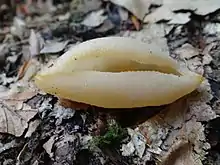| Tarzetta catinus | |
|---|---|
 | |
| Scientific classification | |
| Kingdom: | |
| Division: | |
| Class: | |
| Order: | |
| Family: | |
| Genus: | |
| Species: | T. catinus |
| Binomial name | |
| Tarzetta catinus Holmsk., 1799 | |
Tarzetta catinus is a species of apothecial fungus belonging to the family Pyronemataceae. This is a largely European species with a few records from Mexico and the United States. It appears from spring to autumn as cream-coloured cups up to 5 cm across, usually in small groups among broad-leaved trees, especially beech. The rather similar Tarzetta cupularis is usually a smaller, deeper, flask-shaped cup, but the two species can only be reliably distinguished microscopically: by the shape of the spores (those of T. catinus being broader) and the paraphyses (those of T. catinus having distinctive lobed tips).
The species is inedible.[1]
References
- ↑ Miller Jr., Orson K.; Miller, Hope H. (2006). North American Mushrooms: A Field Guide to Edible and Inedible Fungi. Guilford, CN: FalconGuides. p. 525. ISBN 978-0-7627-3109-1.
Sources
- Jordan, Michael (2004). The Encyclopedia of Fungi of Britain and Europe. Frances Lincoln Publishers. p. 41. ISBN 978-0-7112-2379-0.
- Buczacki, Stefan (1992). Collins Guide to Mushrooms and Toadstools of Britain and Europe. HarperCollins. p. 219. ISBN 978-0-00-219978-0.
External links
This article is issued from Wikipedia. The text is licensed under Creative Commons - Attribution - Sharealike. Additional terms may apply for the media files.